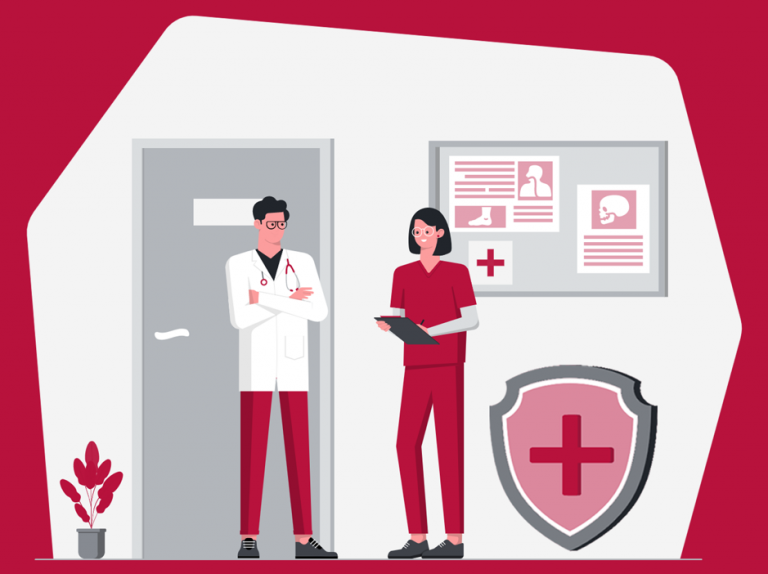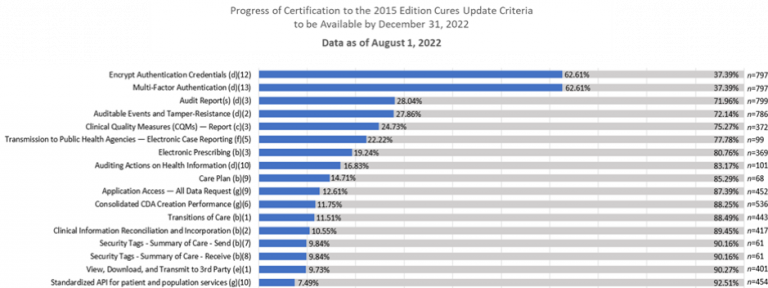
Health data exchange has been a critical challenge in the healthcare industry, and over the last decade, significant progress has been made in standardizing this process. The 21st Century Cures Act is driving far-reaching improvements in interoperability to create new exciting opportunities for the whole industry in 2023 and beyond.
The Cures Act focuses on promoting the implementation of application programming interfaces (APIs) that enable access to information from medical records and other certified IT products without significant effort. The HL7 Fast Healthcare Interoperability Resources (FHIR) standard has emerged as the leading API for health data exchange, and it has matured to become a global standard. The Office of the National Coordinator for Health IT (ONC) and the Centers for Medicare & Medicaid Services (CMS) have designated FHIR v4 as the standard required to fulfill the requirements of the 21st Century Cures Act.
The federal rule states that certified Electronic Health Records (EHRs) must support the standard FHIR APIs by the end of 2022, making sharing information among providers, patients, and public health agencies easier. Although EHR vendors must support FHIR APIs, providers are not required to upgrade to the latest software versions that support them immediately. However, by the end of the third quarter of 2023, providers will need to be running those software versions to participate in CMS payment rules.
This standardization will help make it easier for public health to access data, drive decision-making, and inform patients more quickly and precisely. It will also ensure that healthcare providers have easy access to the most up-to-date health information, ultimately improving patient outcomes. Our team at Itirra, a Seattle-based healthcare software development company, believes that the standardization of FHIR APIs will serve as a critical tool for improving the overall quality and efficiency of the healthcare system. Let’s take a closer look at how the healthcare industry will change in 2023 with FHIR interoperability.
What is ONC’s Cures Act Final Rule?
ONC’s Cures Act Final Rule is a comprehensive regulation that sets out to create a more accessible and interoperable healthcare system that benefits both patients and healthcare providers. The rule is a part of the 21st Century Cures Act, passed in 2016, aiming to accelerate medical research and streamline the drug approval process.
The final rule focuses on several key areas, including adopting standardized APIs, allowing patients to access and manage their health information from different sources through secure and user-friendly applications. The interoperability will also enable healthcare providers to easily exchange health information with other providers, leading to better-coordinated patient care.
The rule also aims to encourage innovation and competition by fostering an ecosystem of new applications that provide patients with more choices in their healthcare. By promoting a more open and transparent healthcare system, the rule empowers patients to take a more active role in their care and to make more informed decisions about their health.

What is the current state of FHIR adoption?
The ONC Cures Act Final Rule has driven the healthcare industry’s efforts to standardize health data exchange. One of the primary requirements of this rule is that certified health IT developers update their technology to be certified to the Cures Update Standardized API criteria for patient and population services by December 31, 2022. However, even before the regulatory requirements were in place, the industry had already seen tremendous adoption of FHIR-based APIs.
As of August 2022, around 5% of certified health IT developers had updated their technology to be certified to the Cures Update Standardized API criteria for patient and population services. However, this five percent supported most in-patient and ambulatory users nationwide, accounting for roughly 66% and 77%, respectively.
Eligible hospitals and Critical Access Hospitals participating in the Medicare Promoting Interoperability program, as well as eligible clinicians participating in the Promoting Interoperability performance category of the Merit-Based Incentive program, will be required to use certified technology updated with the 2015 Cures Update, including FHIR APIs, for performance periods starting in 2023.
Trusted Exchange Framework and Common Agreement (TEFCA) has a FHIR Roadmap explicitly timed to follow directly after the FHIR API deadline in early 2023 to further support the diffusion of API aiming to catalyze nationwide scalability of FHIR-based capabilities.
This roadmap has the potential to expand the use of FHIR-based APIs further, making it even easier for healthcare providers to access and share patient data seamlessly and securely. The standardization is vital to creating a more connected and interoperable healthcare system that can deliver better patient care and outcomes.

What can healthcare professionals expect from FHIR API standardization in 2023?
The healthcare industry has seen a recent push towards the standard FHIR API in EHR systems. Patients and providers alike are eager to access the benefits of the standardized platform. However, some providers have been slow to incorporate the FHIR API into their EHR workflows.
If the standard FHIR API is not already available in a provider’s EHR system, the provider should be asking their vendor where it is. Incorporating this API may take time, but it is expected that by the third quarter of 2023, providers who participate in payment rules will be required to have it as part of their certified electronic health record technology. If you do not yet have a standard FHIR API available and you use a certified EHR, it is recommended that you learn more about what your vendor plans to provide to enable you to participate in 21st-century digital healthcare.
The FHIR Certification Program outlines specific requirements for certified health IT developers, focusing on transparency, fees, and market competition. This program will bring many benefits to clinicians and healthcare providers in 2023. One significant benefit will be the flexibility to connect apps to existing certified health IT systems, thanks to defined timelines for certified health IT developers to register apps. This will give clinicians and healthcare providers more control over their healthcare technology, allowing them to choose the best apps for their needs.
In addition, the FHIR Certification Program will enable access to standardized electronic health information through the USCDI v1 and, if the certified health IT developer chooses to adopt it, USCDI v2. This will make it easier for clinicians and healthcare providers to access critical patient health information, leading to better-informed clinical decisions and improved patient outcomes.
What does FHIR interoperability mean for patient privacy?
There are concerns that consumers may share their health data with non-covered entities using these APIs. Whether these entities are suitable data stewards for such highly sensitive personal data is unclear. It remains to be determined if ONC will oversee these entities to ensure patient privacy or if additional legislation or regulation is required.
Healthcare apps have proliferated in recent years, allowing patients to access medical information, track their health data, and communicate with healthcare providers. However, while these apps offer significant potential benefits, patients must know they are responsible for protecting their data when using them.
A critical point for patients to understand is that if they use an app their healthcare provider does not provide, they are taking their data’s protection into their own hands. This means they are responsible for ensuring that the app they choose has the necessary privacy and security protections and shares information in ways they consider appropriate.
Unfortunately, this responsibility can lead to confusion for many individuals, as they assume that medical record data is protected by laws such as HIPAA regardless of where it is stored. In reality, HIPAA only protects medical record data when it is in the hands of certain entities, such as hospitals, doctors, or health insurers. Patients must be aware that they are responsible for their data once they download it and bring it into apps that they control, which their healthcare provider did not provide.
The lack of clear regulations for healthcare apps outside of HIPAA is also a cause for concern. While the FTC Section Five provision provides some protection, it is not as extensive as patients may believe. Organizations are only required to abide by their published privacy policies, which can be easily overlooked by users who may not read the fine print before agreeing to use the app.
What’s next for FHIR interoperability?
The widespread adoption of FHIR-based standards is expected to revolutionize how public health operates locally and nationally. These modern computing interactions could bring advanced data science capabilities to public health, allowing for more accurate and efficient healthcare decision-making. Some of the most exciting capabilities FHIR-based standards enable include predictive analytics, enhanced surveillance, personalized communications, and streamlined data sharing while preserving patient privacy.
One of the most promising features of FHIR-based standards is predictive analytics. This advanced analytics capability allows public health officials to analyze data from notes, medication orders, lab results, procedure codes, and other data commonly captured in electronic health records. By analyzing this data, public health professionals can identify trends and patterns that may predict health outcomes in certain populations, allowing them to intervene before diseases or conditions worsen. This is particularly important for populations with chronic diseases or behavioral health needs, where early intervention can significantly affect health outcomes.
Another key benefit of FHIR-based standards is enhanced surveillance. Public health officials can stay on top of new disease outbreaks and other health trends by refining and seamlessly deploying case definitions as they evolve. Spatial clustering and enhanced temporal predictions powered by machine learning and artificial intelligence can help link and process data from multiple sources, enabling public health officials to respond more effectively to emerging health threats.
Personalized communications is another exciting feature of FHIR-based standards. With personalized (even two-way) public health communications, care providers and patients can receive customized healthcare messaging based on their specific health needs. This could include reminders to schedule appointments, take medication, or adopt healthier habits, all tailored to the individual patient’s health profile.
Perhaps most importantly, FHIR-based standards offer streamlined data sharing while preserving patient privacy. By ensuring that users at multiple levels (federal, state, and local) can only access the data they need and are authorized to access, FHIR-based standards enable more efficient and effective data sharing. This is a crucial capability in today’s fast-paced healthcare environment, where the ability to quickly and easily access data can make all the difference in patient outcomes.
FHIR Interoperability implementation
Implementing FHIR interoperability in healthcare systems can be a complex and challenging process, requiring significant investment in time, resources, and technical expertise. However, with the help of a seasoned FHIR service provider, organizations can adopt new features and maintain compliance while receiving ongoing support.
Itirra is a Seattle-based healthcare software development company that specializes in healthcare software development services. Our team of experts has the necessary knowledge and experience to develop customized solutions that adhere to FHIR specifications, all while ensuring HIPAA compliance and maintaining the highest level of security.
We believe that FHIR interoperability is critical to transforming the healthcare industry by improving data sharing, increasing efficiency, empowering patients, enhancing care coordination, and enabling better medical research. That’s why we are dedicated to providing the highest quality healthcare software services to our clients.
If you’re looking to embrace FHIR services in your healthcare organization, contact us today to learn more about how we can help you with your interoperability needs.
